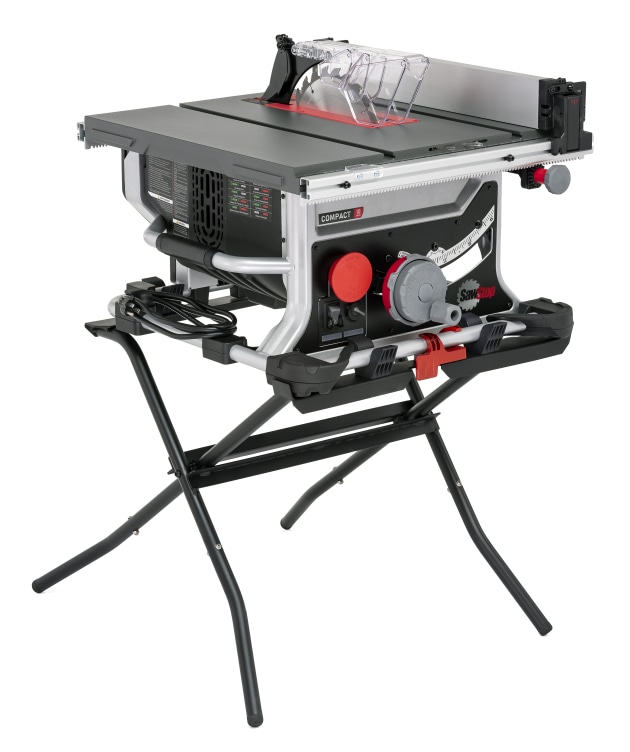TESTED: SawStop compact tablesaw
Review: by Damion Fauser
I recently had the chance to spend some time with the latest addition to the SawStop family, the Compact Tablesaw (CTS). Having owned a similar portable/jobsite saw from a rival brand for many years while I was in the USA, I was very curious to see how this one performed. I’d like to state up front that, whilst provided with a spare cartridge and encouraged to set one off with the ‘hot-dog’ trick that we’ve all seen on YouTube, I chose not to – rather, this is a review of the saw, not the proprietary SawStop Active Injury Mitigation (AIM) system. Currently this saw is selling for $1549 and replacement cartridges are available for $140.
At first glance the functional heritage of this saw is clear – it is designed to be portable and easy to set up and use at off-site workplaces. At 30kg in mass it is best moved as a two-person lift, and care should be taken if attempting to move
by yourself. Overall dimensions are 684 x 597 x 362mm, making it a diminutive machine typical of this size class. At these dimensions it will easily fit inside a wagon or jobsite trailer, and particularly at this height, under the tonneau cover of a styleside ute, allowing it to be secured and kept out of the weather.
Onboard tool storage is well thought out and very handy.
It can be placed on a table surface or on the optional stand ($229), which is sturdy and easy to assemble and disassemble.
Also importantly, all provided accessories are kept within the bounds of these exterior dimensions, with the rip fence and provided pushstick being able to be tucked away underneath the table. There’s also a very clever cabin at the back of the saw for storing adjustment tools (spanners for blade changes and an allen key for fine adjustments), accessory riving knives, clear overhead guard and anti-kickback pawls, as well as the included mitre gauge. Because nothing is loose and everything is contained within its outer dimensions, it makes load planning between jobsites so much easier.
The 2000 watt motor runs from a standard domestic 240V GPO and has plenty of power for making the type of cuts it has been designed for. Running a 10"/254mm blade, maximum cut depth at 90° is 79.5mm and at 45° is 54mm, which are typical specifications for this class. Importantly, it is very clear in the instructions that if the user switches
to a metric 250mm blade, the provided replacement riving knife must be installed and the blade limit stop inside the machine must be adjusted.
The tool ‘cabin’ is cleverly designed – pivot the release and it opens out.
The blade tilts to the left 90–45°, with a fast primary action and a clever fine- adjustment via a rotating bezel on the main control knob. I found returning the blade to a true 90° for standard cutting to be a little inconsistent and required some fussing to achieve the desired level of accuracy. Height adjustment is fast, easy and secure with the primary control knob.
Care must be taken when selecting blades, as SawStop make it clear that blades with depth-limiting shoulders may affect the performance of the AIM system. Minimum blade kerf is stated as 3/32" (2.4mm), and using a fine-kerf blade could assist in reducing power draw.
Also of note is that this saw is not designed to be used with dado stacks, limiting the versatility of the tool. Blade changes are simple and fast with the quick-release throat plate and easy access to the 5/8" arbor for the two included crank-neck spanners.
The controls are large and obvious, a feature I like to see on machines, and I particularly like that you can insert a padlock through the bracket containing the main control switch, preventing unauthorised use.
Dust control is below the table only and is collected via a reasonably standard 58/65mm inner/outer diameter port. Recommended minimum air draw is 170 cfm.
Adjustment tools and accessories are easy to transport and access.
The rip fence is fixed at the front and rear of the table on a unique paired set of rack/pinion rails, with adjustments easily made via a rotating control knob at the front of the machine. Pull the knob out, rotate until the desired setting is achieved, and secure by pushing the knob back in. Simple.
The table is made of a reduced friction material and is flat enough. The throat plate has self-levelling grub screws which is a good feature. Of particular note is the built-in adjustability of this machine. Simple and detailed instructions make it clear how to fine- tune the riving knife within the kerf: align the blade to the mitre slots and the rip fence to the mitre slots.
This saw is a neat and tidy little machine that is cleverly designed for its intended use. With diligent calibration and
pairing with quality blades and shop-made custom accessories such as crosscut sleds, users of all levels will be able to make premium quality cuts in workpieces of an appropriate scale. This isn’t a panel saw, so don’t expect it to perform like a panel saw.
Machine supplied by and available from Carbatec, www.carbatec.com.au
Damion Fauser is a Brisbane based furniture designer/maker who also teaches woodwork classes. See damionfauser.com






